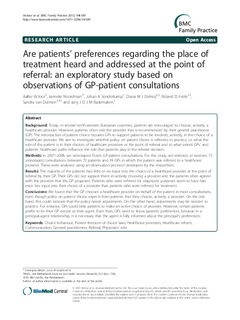| dc.identifier.citation | Victoor, A., Noordman, J., Sonderkamp, J. A., Delnoij, D. M., Friele, R. D., Van Dulmen, S., & Rademakers, J. J. D. J. M. (2013). Are patients’ preferences regarding the place of treatment heard and addressed at the point of referral: an exploratory study based on observations of GP-patient consultations. BMC Family Practice, 14:189. doi: 10.1186/1471-2296-14-189 | no_NO |
| dc.description.abstract | Background: Today, in several north-western European countries, patients are encouraged to choose, actively, a healthcare provider. However, patients often visit the provider that is recommended by their general practitioner (GP). The introduction of patient choice requires GPs to support patients to be involved, actively, in the choice of a healthcare provider. We aim to investigate whether policy on patient choice is reflected in practice, i.e. what the role of the patient is in their choices of healthcare providers at the point of referral and to what extent GPs’ and patients’ healthcare paths influence the role that patients play in the referral decision.
Methods: In 2007–2008, we videotaped Dutch GP-patient consultations. For this study, we selected, at random, 72 videotaped consultations between 72 patients and 39 GPs in which the patient was referred to a healthcare provider. These were analysed using an observation protocol developed by the researchers.
Results: The majority of the patients had little or no input into the choice of a healthcare provider at the point of referral by their GP. Their GPs did not support them in actively choosing a provider and the patients often agreed with the provider that the GP proposed. Patients who were referred for diagnostic purposes seem to have had even less input into their choice of a provider than patients who were referred for treatment.
Conclusions: We found that the GP chooses a healthcare provider on behalf of the patient in most consultations, even though policy on patient choice expects from patients that they choose, actively, a provider. On the one hand, this could indicate that the policy needs adjustments. On the other hand, adjustments may be needed to practice. For instance, GPs could help patients to make an active choice of provider. However, certain patients prefer to let their GP decide as their agent. Even then, GPs need to know patients’ preferences, because in a principal-agent relationship, it is necessary that the agent is fully informed about the principal’s preferences. | no_NO |
